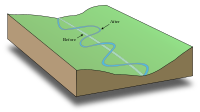
Photo from wikipedia
Sediment is sorted in river bends under the influence of gravity that pulls the heavier grains downslope and secondary flow that drags the finer grains upslope. Furthermore, when dunes are… Click to show full abstract
Sediment is sorted in river bends under the influence of gravity that pulls the heavier grains downslope and secondary flow that drags the finer grains upslope. Furthermore, when dunes are present, sediment is also sorted vertically at the dune lee side. However, sorting functions are poorly defined, since the relation to transverse bed slope and the interaction between lateral and vertical sorting is not yet understood for lack of data under controlled conditions. The objective of this study is to describe lateral sorting as a function of transverse bed slope and to gain an understanding of the interaction between lateral and vertical sorting in river bends. To this end, experiments were conducted with a poorly sorted sediment mixture in a rotating annular flume in which secondary flow intensity can be controlled separately from the main flow velocity, and therefore transverse bed slope towards the inner bend and dune dimensions can be systematically varied. Sediment samples were taken along cross-sections at the surface of dune troughs and dune crests, and over the entire depth at the location of dune crests (bulk samples), which enabled comparison of the relative contribution of vertical sorting by dunes to lateral sorting by the transverse bed slope. The data show that lateral sorting is always the dominant sorting mechanism in bends, and bulk samples showed minor effects of vertical sorting by dunes as long as all grain-size fractions are mobile. An empirical bend sorting model was fitted that redistributes the available sediment fractions over the cross-section as a function of transverse bed slope. Comparison with field data showed that the model accurately reproduces spatially-averaged trends in sorting at the bend apex in single-thread channels. The bend sorting model therefore provides a better definition of bend sorting with conservation of mass by size fraction and adds to current understanding of bend sorting. The implication for numerical modelling is that bend sorting mechanisms can be modelled independently of dunes, allowing the application of the active layer concept.
Journal Title: Sedimentology
Year Published: 2019
Link to full text (if available)
Share on Social Media: Sign Up to like & get
recommendations!